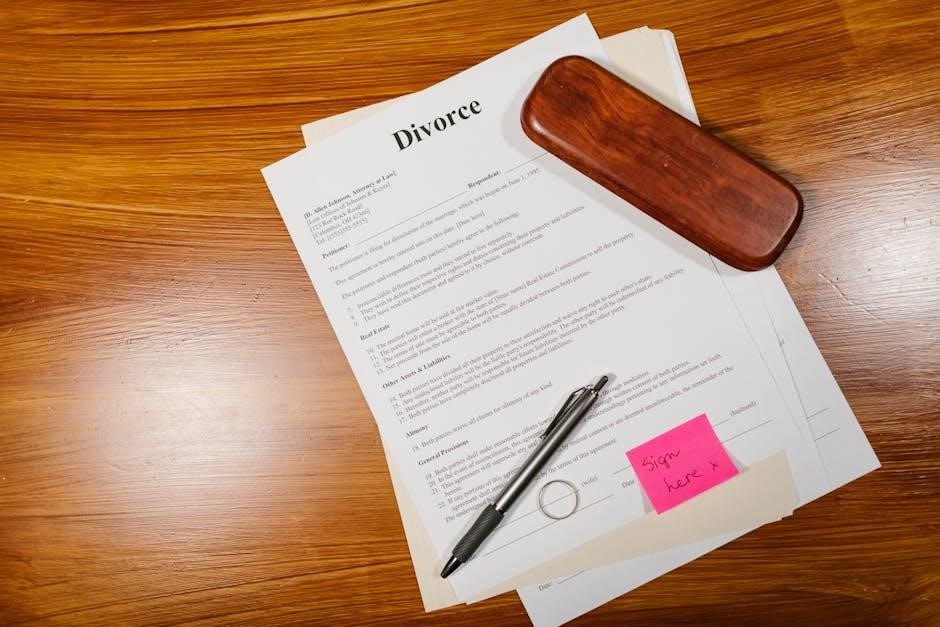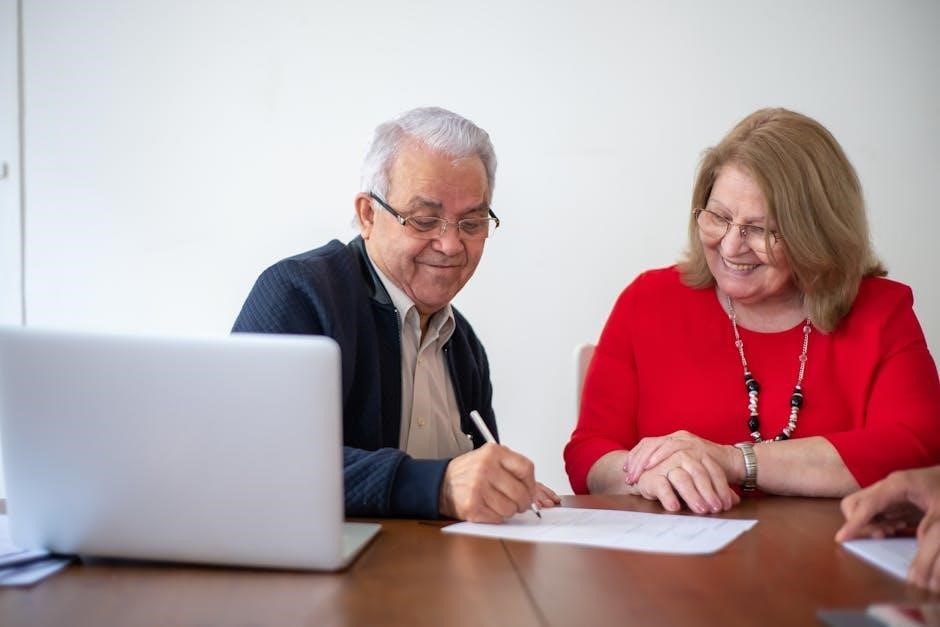elder care agreement form 85 pdf

The Elder Care Agreement Form 85 is a comprehensive legal document designed to outline the terms and conditions of care for elderly individuals․ It establishes clear guidelines for responsibilities, compensation, and services, ensuring a mutually beneficial arrangement for both caregivers and seniors․ This form is essential for creating a structured and legally binding care plan, adaptable to the senior’s evolving needs and fostering trust in the caregiving relationship․
Definition of Elder Care Agreement Form 85
The Elder Care Agreement Form 85 is a legal document designed to formalize caregiving arrangements between an elderly individual and their caregiver․ It outlines the terms and conditions of care, including responsibilities, compensation, and services provided․ This form ensures clarity and mutual understanding, serving as a contract that protects both parties․ It typically covers aspects such as daily care tasks, financial arrangements, and expectations for the caregiver․ The document is adaptable to the senior’s changing needs, making it a flexible and essential tool for establishing a structured caregiving relationship․ By defining roles and obligations, it helps prevent disputes and ensures the elder’s well-being is prioritized․
Purpose of the Elder Care Agreement Form 85
The purpose of the Elder Care Agreement Form 85 is to establish a clear and legally binding arrangement between an elderly individual and their caregiver․ It aims to outline the terms of care, including responsibilities, compensation, and services provided, ensuring both parties understand their roles․ This document helps prevent disputes by providing a structured framework for caregiving․ It also ensures the elderly individual’s needs are met while protecting the caregiver’s rights․ The form is designed to promote transparency, accountability, and mutual agreement, fostering a trusting relationship․ By defining expectations, it helps maintain the senior’s quality of life and provides peace of mind for all involved․

Structure of the Elder Care Agreement Form 85
The form is organized into clear sections, detailing parties involved, services provided, compensation terms, caregiving responsibilities, and legal formalities, ensuring a comprehensive framework for elder care arrangements․
Key Components of the Form
The Elder Care Agreement Form 85 includes essential components such as the caregiver’s responsibilities, compensation terms, service duration, and the scope of care provided․ It also outlines the rights and expectations of both the caregiver and the elder, ensuring clarity and mutual understanding․ The form includes sections for detailing specific care needs, such as medical requirements, dietary restrictions, and transportation arrangements․ Legal requirements, like witnesses and notarization, are also addressed to ensure the document’s validity․ Additionally, the form provides a framework for addressing financial matters, such as payment terms and property transfers, if applicable․ These components work together to create a comprehensive and legally binding agreement tailored to the elder’s needs․
Sections and Subsections of the Document
The Elder Care Agreement Form 85 is organized into clear sections and subsections to ensure thorough coverage of all aspects of the care arrangement․ The document typically begins with parties involved, outlining the identities and roles of both the caregiver and the elder․ Next, it details the scope of care services, including specific responsibilities such as daily living assistance, medical care, and household tasks․ The form also includes sections on compensation and payment terms, duration of the agreement, and termination clauses․ Additional subsections address legal requirements, such as witness signatures and notarization, ensuring the document’s validity․ Each section is designed to provide clarity and structure, making the agreement comprehensive and legally sound․

Importance of Each Section
Each section of the Elder Care Agreement Form 85 plays a vital role in ensuring a clear and legally binding arrangement․ The parties involved section establishes accountability, while the scope of care services ensures both parties understand their obligations․ Compensation and payment terms prevent financial disputes, and duration and termination clauses provide flexibility and security․ Legal sections, including witness signatures and notarization, validate the document, protecting both the caregiver and the elder․ Together, these sections foster trust, transparency, and accountability, ensuring the elder’s needs are met while safeguarding the caregiver’s rights․ This structured approach minimizes conflicts and provides peace of mind for all involved․
Legal Requirements and Compliance
The Elder Care Agreement Form 85 must comply with state-specific laws and regulations to ensure enforceability․ Key legal requirements include witness signatures and notarization to validate the document․ Both parties must have the capacity to enter a legal agreement, with the elder being of sound mind or represented by a legal guardian․ The form must clearly outline compensation terms, care responsibilities, and termination clauses to avoid disputes․ Compliance with local elder care laws and ethical standards is essential to protect both the caregiver and the senior․ Legal counsel is often recommended to review the document, ensuring all requirements are met and the agreement is legally binding․ This ensures peace of mind and protection for all parties involved․

Benefits of Using the Elder Care Agreement Form 85
The Elder Care Agreement Form 85 provides clarity in caregiving responsibilities, offers legal protection for both parties, ensures financial transparency, and fosters peace of mind for seniors and caregivers․
Clarity in Caregiving Responsibilities
The Elder Care Agreement Form 85 ensures clear delineation of caregiving responsibilities, preventing misunderstandings and conflicts․ By outlining specific tasks, duties, and expectations, the document provides a structured framework for both caregivers and seniors․ This clarity helps establish a consistent routine, addressing daily needs, medical requirements, and household management․ The form also allows for adjustments as the senior’s condition evolves, ensuring the care provided remains relevant and effective․ Having a well-defined plan fosters accountability and peace of mind, knowing that the senior’s well-being is prioritized․ This transparency is crucial for maintaining trust and harmony in the caregiving relationship, making it a vital component of the agreement․
Legal Protection for Both Parties
The Elder Care Agreement Form 85 provides robust legal protection for both the caregiver and the elderly individual․ By clearly defining responsibilities, compensation, and expectations, the document safeguards against potential disputes or misunderstandings․ It ensures that the caregiver’s efforts are recognized and fairly compensated, while the senior’s rights and needs are protected․ The form also outlines the scope of services, preventing overreach or exploitation․ Legal compliance and notarization further strengthen the agreement, making it enforceable in court if necessary․ This mutual protection fosters trust and security, ensuring both parties feel confident in their arrangement․ The form’s legal framework guarantees clarity and fairness, benefiting everyone involved in the caregiving relationship․
Financial Transparency and Planning
The Elder Care Agreement Form 85 ensures financial transparency and planning by detailing compensation terms, payment schedules, and reimbursement processes․ It outlines the caregiver’s remuneration, whether through direct payments, property transfers, or other forms of compensation․ The document also addresses tax implications, ensuring both parties understand their financial obligations․ By clarifying these aspects, the form prevents disputes and promotes a stable financial environment for caregiving․ It allows for the management of the elder’s assets and resources, ensuring they are used responsibly to meet their care needs․ This financial clarity provides security for both the caregiver and the senior, fostering a fair and organized care arrangement․ Proper documentation and legal compliance further safeguard the agreement’s financial aspects․
Peace of Mind for Seniors and Caregivers
The Elder Care Agreement Form 85 provides peace of mind for both seniors and caregivers by establishing a clear, mutually understood plan․ Seniors gain assurance knowing their needs will be met, while caregivers are confident in their roles and responsibilities․ The document addresses financial, legal, and care-related concerns, reducing uncertainty and potential conflicts; It ensures that the senior’s wishes are respected and that caregivers are fairly compensated, fostering a trusting relationship․ This clarity and structure alleviate anxiety, allowing both parties to focus on the senior’s well-being without financial or emotional strain․ The agreement’s transparency and legal safeguards create a sense of security, enabling a harmonious and supportive caregiving environment․

Legal Considerations for the Elder Care Agreement Form 85
The Elder Care Agreement Form 85 must comply with state-specific laws, ensuring enforceability and protecting both parties’ rights․ Legal counsel is often recommended to verify compliance and address potential disputes, guaranteeing the document’s validity and adaptability as the senior’s needs evolve over time․
Contractual Obligations and Enforceability
The Elder Care Agreement Form 85 establishes legally binding obligations between the caregiver and the senior, ensuring both parties understand their responsibilities․ For enforceability, the document must comply with state laws and include clear terms regarding compensation, services, and property transfers․ Legal counsel is often recommended to review the agreement, preventing future disputes․ The form’s enforceability relies on mutual consent, transparency, and adherence to legal standards․ Proper execution, including notarization and witness signatures, strengthens its validity․ This ensures the agreement is upheld in court if necessary, protecting both parties’ interests and maintaining the integrity of the caregiving arrangement․ Compliance with local regulations is essential for its legal standing․
State-Specific Laws and Regulations
Elder Care Agreement Form 85 must comply with state-specific laws and regulations, as legal requirements vary by jurisdiction․ Each state may have unique rules regarding caregiver compensation, property transfers, and asset management․ Legal experts recommend tailoring the agreement to meet local laws to ensure validity․ For instance, some states require notarization or witness signatures, while others mandate specific disclosures․ Failure to adhere to state laws can render the agreement unenforceable․ It’s crucial to consult legal counsel familiar with local regulations to draft a compliant document․ Certain states, like California, have specific requirements for caregiver agreements, emphasizing transparency and fairness․ Ensuring compliance with state laws protects both parties and maintains the agreement’s legal integrity․
Role of Witnesses and Notarization
The Elder Care Agreement Form 85 often requires the involvement of witnesses and notarization to ensure its authenticity and legal enforceability․ Witnesses are typically impartial individuals who verify that both parties willingly enter the agreement, while notarization confirms the identities of the signatories․ Some states mandate notarization for such documents, while others may require at least two witnesses․ The presence of witnesses ensures that the agreement is executed without coercion or undue influence, protecting both the caregiver and the senior․ Notarization adds an additional layer of legal validity, making the document more robust in court if disputes arise․ This formal process ensures clarity and mutual understanding, safeguarding the interests of all parties involved and preventing future misunderstandings․

How to Complete the Elder Care Agreement Form 85
Complete the form by gathering necessary information, filling in each section step-by-step, and reviewing the document for accuracy․ Ensure all parties understand the terms before signing․
Gathering Necessary Information
To complete the Elder Care Agreement Form 85, gather all necessary details, including the senior’s personal information, caregiver’s contact data, and specific care requirements․
List the types of care services needed, such as daily living assistance, medical support, or household management․
Include compensation details, like payment terms, hourly rates, or property transfers․
Note any legal requirements, such as power of attorney or estate planning documents․
Document the senior’s preferences, dietary restrictions, and medical conditions․
Ensure all information is accurate and up-to-date to avoid future disputes․
This step ensures the agreement is tailored to the senior’s needs and compliant with legal standards․
Gathering thorough information is the foundation for a clear and enforceable care plan․
Step-by-Step Filling Process
Filling out the Elder Care Agreement Form 85 requires careful attention to detail․
First, identify the parties involved, including the senior and caregiver, with their full names and contact information․
Next, outline the scope of caregiving services, such as daily tasks, medical assistance, or household support․
Specify the compensation terms, including payment methods, rates, and schedules․
Include any legal provisions, such as property transfers or power of attorney references․
Define the agreement’s term, including start and end dates, and conditions for termination․
Ensure all parties sign and date the document, with witnesses or notarization as required․
This structured approach ensures clarity and legality, protecting both the senior and caregiver․
Reviewing and Finalizing the Document
After completing the Elder Care Agreement Form 85, it is crucial to thoroughly review the document for accuracy and completeness․
Ensure all terms, responsibilities, and compensation details are clear and agreed upon by both parties․
Legal counsel should be consulted to verify compliance with state laws and regulations․
Once satisfied, all parties must sign and date the document in the presence of witnesses or a notary, as required․
Finally, store the original in a safe place and provide copies to all involved․ This step ensures the agreement is legally binding and enforceable, protecting both the senior and caregiver․ Regular reviews and updates are recommended to reflect changing needs or circumstances․

Common Mistakes to Avoid When Using the Form
Common mistakes include omissions in caregiving responsibilities, incorrect signatures, and failure to update the agreement․ Ensure clarity and completeness to avoid legal disputes and ensure enforceability․
Omissions in Caregiving Responsibilities
Omissions in caregiving responsibilities are a common mistake in Elder Care Agreement Form 85․ This can lead to misunderstandings and legal disputes․ Caregivers and seniors must ensure all tasks, such as daily care, medical needs, and financial support, are explicitly detailed․ Vague or missing information can result in unmet expectations and conflicts․ Regular reviews and updates to the agreement are essential to address evolving needs․ Failing to include specific duties or compensation terms can lead to disputes over responsibilities․ Clear, detailed descriptions of caregiving roles are crucial to avoid misunderstandings and ensure the senior’s well-being is prioritized․ Proper documentation protects both parties and ensures a fair, enforceable agreement․
Incorrect or Missing Signatures
Incorrect or missing signatures are critical errors in the Elder Care Agreement Form 85․ For the document to be legally enforceable, all parties involved, including the caregiver and the senior, must sign it․ Witnesses or notarization may also be required, depending on state laws․ Missing signatures can invalidate the agreement, leading to disputes and legal complications․ Caregivers may not receive compensation, and seniors may lose protections guaranteed by the contract․ It is essential to ensure all signatures are present, correctly dated, and witnessed if necessary․ Double-checking this step prevents future conflicts and ensures the agreement’s validity; Proper execution is crucial for both parties to rely on the document legally․
Failure to Update the Agreement
Failure to update the Elder Care Agreement Form 85 can lead to significant issues as the senior’s needs evolve․ The document must reflect changes in caregiving responsibilities, financial arrangements, or medical requirements․ Without updates, the agreement may no longer address the senior’s current situation, leading to misunderstandings or inadequate care․ For instance, if the senior’s health declines, the caregiver’s duties may expand, but the original agreement won’t account for these changes․ Regular reviews and updates ensure the document remains relevant and protects both parties․ Neglecting this step can result in disputes, financial complications, or legal vulnerabilities․ It is crucial to revisit and revise the agreement periodically to maintain its effectiveness and validity․

Elder Care Agreement Form 85 and Financial Planning
The Elder Care Agreement Form 85 aids in structuring financial aspects of caregiving, including compensation, tax implications, and property transfers, ensuring clarity and security for all parties involved․
Compensation and Payment Terms
Compensation and payment terms in the Elder Care Agreement Form 85 are crucial for ensuring clarity and fairness․ The document outlines how caregivers will be reimbursed, whether through hourly rates, flat fees, or other agreed-upon methods․ It specifies payment schedules, such as monthly installments or reimbursements for expenses, to avoid disputes․ The form also addresses potential deductions or bonuses based on performance․ By detailing these financial aspects upfront, both parties can avoid misunderstandings and ensure a smooth caregiving relationship․ Proper documentation of compensation terms is essential for legal compliance and maintaining trust between the caregiver and the elderly individual or their representatives․
Tax Implications of Caregiving
The Elder Care Agreement Form 85 PDF outlines the tax implications of caregiving to ensure compliance with legal and financial regulations․ Caregivers may need to report compensation as taxable income, while expenses related to care can be deductible․ The document clarifies whether payments are classified as gifts or income, affecting tax obligations․ It also addresses potential tax benefits for seniors, such as medical expense deductions․ Proper documentation is essential to avoid disputes and ensure both parties meet their tax responsibilities․ Consulting a tax professional is recommended to navigate these complexities and optimize financial outcomes for all involved․
Property Transfer and Asset Management
The Elder Care Agreement Form 85 PDF may include provisions for property transfer and asset management, allowing seniors to transfer assets, such as their home, to caregivers․ This arrangement is often used to compensate caregivers for their services while ensuring the senior’s financial security․ The document outlines the terms of such transfers, including ownership rights and obligations․ It also addresses how assets will be managed during the senior’s lifetime or after their passing․ Proper documentation ensures the agreement aligns with the senior’s wishes and prevents future disputes․ Legal safeguards are in place to protect both parties’ interests, making the process transparent and legally binding․ This section is crucial for maintaining clarity and fairness in asset distribution․

Case Studies and Real-World Applications
The Elder Care Agreement Form 85 PDF has been successfully applied in various real-life situations, showcasing its effectiveness in addressing caregiving challenges and ensuring fair compensation arrangements․
Success Stories of Elder Care Agreements
Many families have benefited from the Elder Care Agreement Form 85 PDF, which has helped clarify caregiving responsibilities and compensation; For instance, Mrs․ Thompson used the form to outline her adult child’s caregiving duties, ensuring fairness and preventing disputes․ Similarly, John and Emily utilized the document to legally and financially plan for their mother’s care, fostering trust and accountability․ These success stories highlight how the form provides a clear framework, adapting to unique family situations, such as live-in care or managing medical needs․ By establishing mutually agreed-upon terms, the Elder Care Agreement Form 85 PDF has proven to be an invaluable tool for protecting both seniors and caregivers, promoting harmonious caregiving relationships․
Challenges Faced in Implementing the Agreement
Implementing the Elder Care Agreement Form 85 PDF can present challenges, such as resistance from family members unfamiliar with legal formalities․ Caregivers may struggle to quantify their services, leading to disputes over compensation․ Emotional tensions can arise when balancing financial planning with the senior’s autonomy․ Additionally, the agreement’s complexity may require legal assistance, which can be costly․ Ensuring the document remains updated as the senior’s needs evolve is another challenge․ Despite these hurdles, the form provides a framework to address such issues proactively, fostering clarity and accountability in elder care arrangements․ Proper execution and open communication are key to overcoming these challenges effectively․

Future Trends in Elder Care Agreements
The future of elder care agreements likely involves digitalization, with online platforms streamlining document creation and management․ Legal counsel’s role may expand to ensure compliance with evolving regulations and protect both parties’ interests effectively․
Digitalization of Care Agreements
The digitalization of elder care agreements is transforming how these documents are created, managed, and accessed․ Online platforms now offer templates like the Elder Care Agreement Form 85 in PDF format, enabling easy customization and digital signatures․ This shift enhances accessibility, reduces paperwork, and ensures documents are securely stored and easily retrievable․ Digital tools also facilitate real-time collaboration between caregivers, seniors, and legal professionals, streamlining the agreement process․ Additionally, digital platforms can automate updates, ensuring the agreement evolves with the senior’s needs․ This trend not only improves efficiency but also reduces errors, making care agreements more reliable and enforceable․ Legal professionals are increasingly embracing these tools to ensure compliance and protect all parties involved․
Increasing Role of Legal Counsel
The role of legal counsel in elder care agreements is expanding significantly, ensuring compliance with state-specific laws and protecting the interests of both seniors and caregivers․ Legal professionals assist in drafting and reviewing agreements to prevent disputes and ensure enforceability․ Their expertise is crucial in addressing complex issues, such as property transfers and asset management․ Legal counsel also helps navigate tax implications and guardianship matters, ensuring the agreement aligns with the senior’s wishes and legal standards․ This involvement not only enhances the agreement’s validity but also provides peace of mind for all parties․ As elder care agreements grow more intricate, the need for skilled legal guidance becomes essential to avoid potential legal pitfalls and ensure fairness․ Legal counsel plays a vital role in safeguarding the rights and well-being of seniors and their caregivers alike․
Leave a Reply
You must be logged in to post a comment.